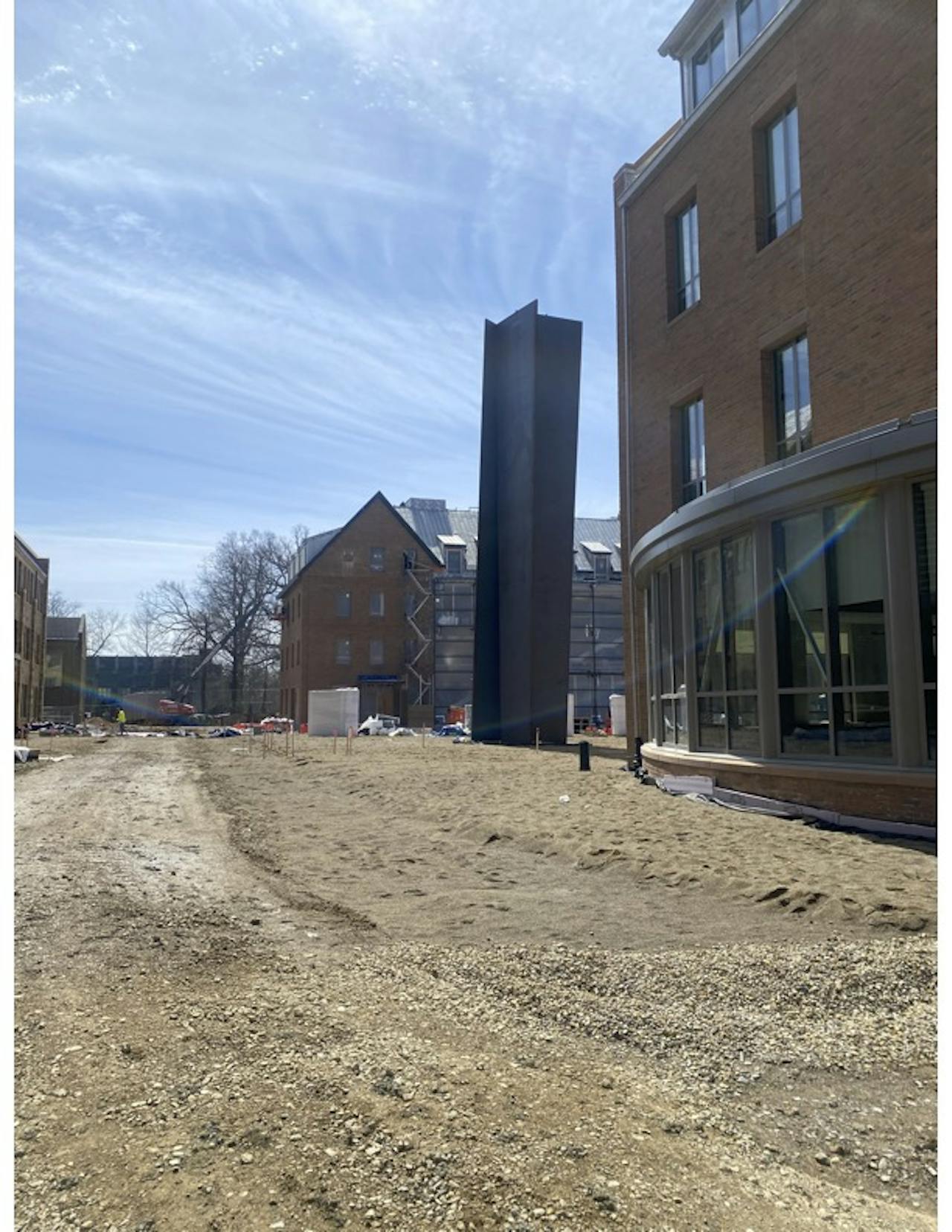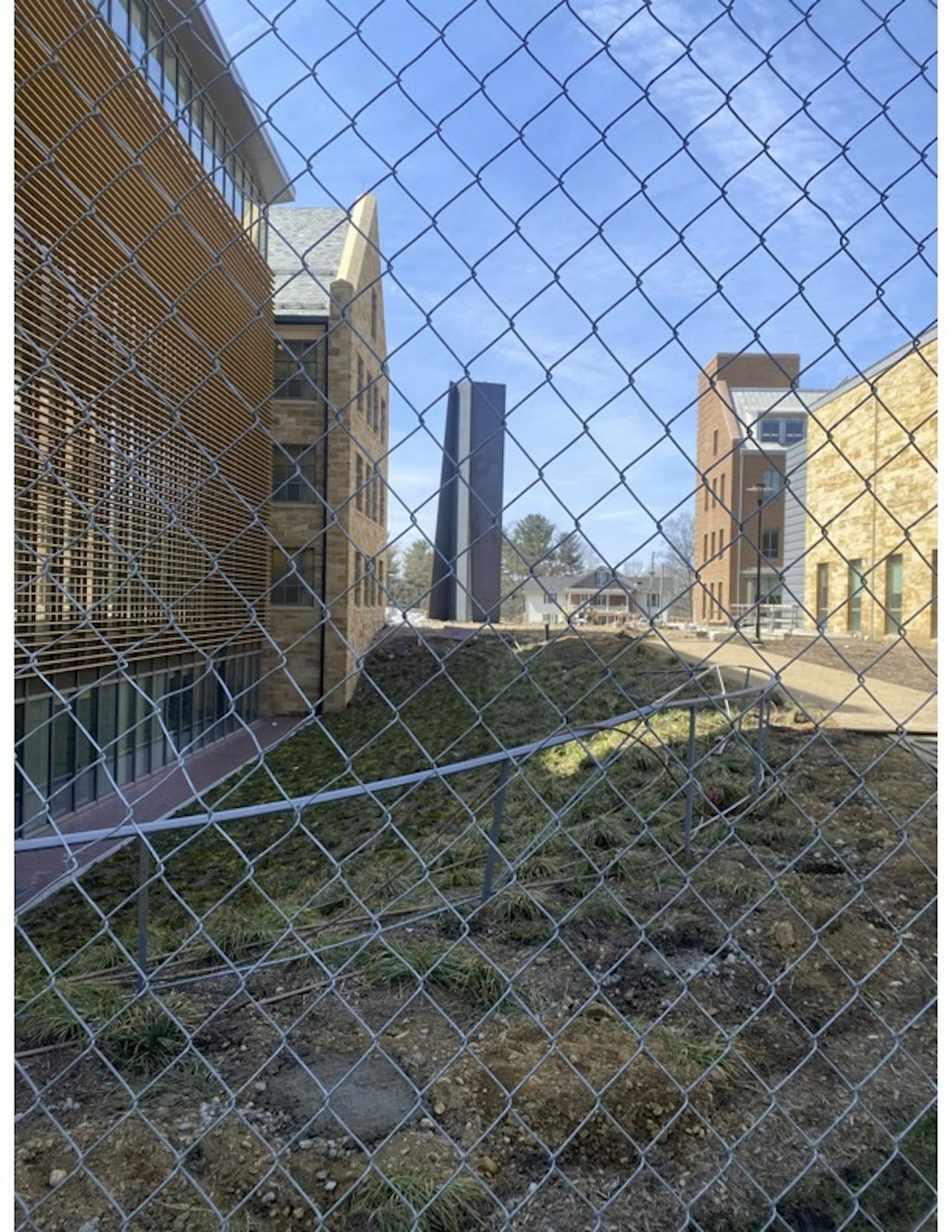Richard Serra's "Pivot" Statue Isn't Supposed To Make Sense
Sculpture invokes many emotions, but none have left me quite as speechless as Richard Serra’s Pivot. Our initial encounter was in August of 2021, through the paned glass of a third-floor Chalmers Library window. I remember being intrigued by the massive panels of steel, but more so confused as to what it was supposed to mean. I lack a natural inclination towards art, so at first I didn’t quite possess the vocabulary to describe how I felt about it. The more time that I have spent thinking about Pivot, the more I have been able to comprehend it.
To understand Pivot you must first understand the man behind it: renowned American sculptor Richard Serra. Serra is something of an enigma. His work is primarily done in hulking swaths of steel, his love of which likely stems from a childhood fascination with the shipping industry and a job working in a steel mill during college. Serra earned degrees in English Literature and Art History from the University of California, Santa Barbara and Yale University before beginning his lucrative sculpting career in Europe, where he studied the work of Constantin Brancusi.
Serra is, as the New York Times’s art critic Deborah Solomon describes him, an “unapologetic formalist,” more concerned with the process of creation than any visual aesthetic. He is interested in experimenting with qualities of mass and weight rather than our typical understanding of art for the sake of visual pleasure. This hardline approach to sculpture is visible in Serra’s distinctive industrial style. Warmth is absent from his pieces, which tends to turn people off to his otherwise fascinating configurations, which are typically of great scale.
To “pivot” is to rotate, turn, or swing around a central point. Wheels pivot, basketball players pivot, and Serra’s sculpture pivots. Serra draws inspiration from his famous “verb list,” which is exactly what it sounds like. At some point in the late 60s or early 70s, Serra produced a list of more than 50 verbs, which would go on to inform the actions he performed on his pieces. The verb list has come to define the movement of “Process Art,” of which Serra is one of the primary geniuses. To Serra, art is the act of creation, rather than a polished final product.
Tilted Arc, a curved sheet of steel that bisected a Manhattan Plaza in the 1980s, illustrates the disillusion a lot of people feel towards Serra’s work. The General Services Administration (GSA) commissioned Serra to design a site-specific piece in an area ripe with modernist and abstract pieces. The sculpture, which appeared as a rust steel wall blocking the path, impeded people’s ability to travel easily from building to building, and cast a dreary shadow over the people who worked nearby. Those closeby viewed Tilted Arc as a nuisance rather than a spectacle of art, and as one worker complained, “[$175,000] was a lot of public money to spend on a ‘rusted metal wall.’” Complaints about Tilted Arc’s oppressiveness led to its removal by the government in 1989.

Site-specific works like Serra’s Tilted Arc and Kenyon’s own Pivot are designed explicitly for a specific location. These sculptures are created in harmony with their location, and likely carry a deeper purpose. The broader context of Serra’s sculptures is that they challenge and influence the way we interact with both the art and our environment. Public, site-specific art is made to be engaged with, not fought over.
Pivot is not quite so obstructive. The sculpture is a gift from Graham Gund ‘63 H’81 and his wife, who are generous patrons of art at the College. Pivot will join the permanent collection of art at Kenyon as the first Serra piece. Pivot was installed in the summer of 2021. Located at the heart of the College’s still in-construction West Quad, the 60-foot sculpture looms over the flat Ohio terrain. Five panels of steel are arranged incongruously around an invisible point. To the naked eye, it looks more like an ambitious construction project than a finished art installation. But for Serra, that’s sort of the point. Pivot’s panels mirror those of his 2019 structure, echo, located in São Paulo, Brazil. Both sculptures are composed of towering sheets of metal arranged to draw attention.
Pivot is unlike any of the other artwork it’s showcased alongside on campus. Buildings like Ascension Hall and even Rosse Hall– modeled after more classical styles of architecture– stand in contrast to Pivot’s industrial prowess. Perhaps it is ushering in a new age for Kenyon’s architectural aesthetic; West Campus is already awash with several new buildings that offer a more modern feel to the otherwise gothic surroundings, including the Gund Gallery and Chalmers Library. Daisy Desrosiers, director and chief curator of the Gund Gallery, believes that the introduction of Pivot will transform the campus. “It may reveal the site of the campus in new ways by creating new connections between architectural references in contrast with the bucolic landscapes of Gambier,” she said in an interview.
The impact of the presence of a Serra sculpture on campus can’t be overstated. Pivot is one of only ten Serra tower sculptures worldwide. According to Desrosiers, Kenyon’s possession of a Serra sculpture makes it a site of great artistic significance: “[Pivot] will attract many visitors and help to solidify Kenyon, and the Gund Gallery, as a place to see and engage with high-quality works of contemporary art.”

Pivot stands out on Kenyon’s campus in part due to its sheer size, and its centralized location in the West Quad. From the upper levels of Chalmers library, to Middle Path, to the Gund Gallery to the English Quad, Pivot is a visible landmark. Andrea Myers, visiting professor of sculpture, sees Pivot as an extension of architectural space. “It becomes like another building in a way, related to architecture because of its scale,” said Myers. “It’s like a skyscraper tower in a way that is not used for an interior space.”
Thinking of Pivot as a process rather than a static, unchanging entity influences our understanding of the sculpture. Over time the steel will start to rust, which will alter the way the artwork is perceived. Pivot can also be viewedthroughout the different seasons, as the community observes how it changes with the weather. Desrosiers is excited to continue getting to know the piece in these different settings: “This is an element of the piece that will keep revealing itself and, equally, will keep engaging us as viewers.”
The installation process for Pivot in June of 2021 was a laborious one. Each 60-ton steel panel had to be lifted into place by crane. This is typical of Serra’s work, which is largely site-specific. What this means for Pivot, is that it was designed specifically for the site at Kenyon. Serra worked with a scale model of the West Quad area to design the piece, which was later built and installed using heavy-duty machinery. Like a composer, Serra directs a symphony of steel into action, creating something out of nothing. Every move is intentional, from the location to the medium to the scale. But until the Quad itself is complete, Pivot won’t be considered a finished work. Desroisiers explained the integral relationship between a sculpture like Pivot and the site in which it is placed. Currently, Pivot rests awkwardly on a stretch of pavement littered with proof of construction. In time, as the Quad comes together, grass will blanket the base of the sculpture so that Pivot appears to emerge naturally from the ground. “We consider the sculpture to be complete when people can walk through it and experience it for themselves,” said Desrosiers.
Reactions to Pivot have been mixed, with most students wondering just what exactly it means. As a formalist, Serra has long been uninterested in finding any further meaning in the cold, impersonal slabs of steel he welds into works of art. Serra once told the New York Times that “any metaphor [his sculptures] suggest are accidental and wholly irrelevant.”
Serra is a master of provocation, and the very work he creates for the public undermines his insistence on his sculptures having no deeper implications. Public art invites viewers to interact with, appreciate, and question it. Serra’s Pivot provides us with a vehicle for that discussion. Myers believes that Serra’s intent to provoke opens up avenues for further interpretation and exploration: “I think that he places works to create dialogue and impact in the space,” she said. “I’m sure there will be some people who think it’s great and some people for whom it doesn’t resonate.”
There is beauty in the art we can appreciate together. To that end, Pivot brings the community together in a mutual fascination with something we cannot understand. That everyone brings a different perspective on Pivot to the table is the purpose of public art.
